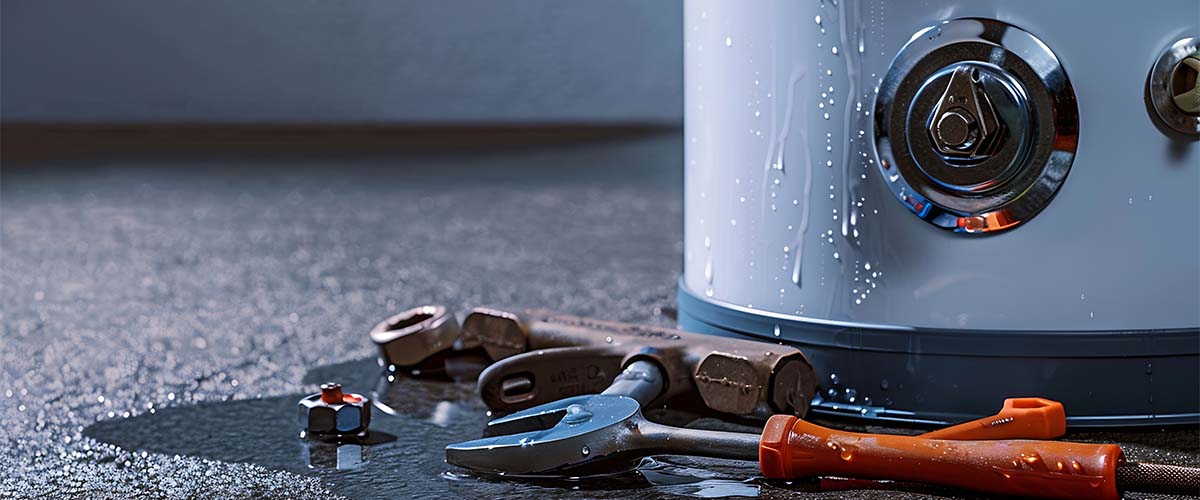The water heater’s rattling like a shopping cart with a bad wheel—hollow thunk, a hiss, maybe a whistle that comes and goes when someone showers. Take a breath. Most water heater noise points to sediment, pressure, or a loose part—not a flood. After two decades in Winston-Salem utility closets, I can tell you what matters, what doesn’t, and when to shut it down. Two words: safety first. Then we’ll track the noise in a smart order so a Saturday annoyance doesn’t turn into a Monday emergency.
Noise from Water Heater – Causes
A few water heater noises are normal. A soft whoosh when the burner lights. Gentle ticking as pipes expand. A light hum on electric units. Those aren’t red flags.
What’s not safe? Loud popping or rumbling. It usually means sediment baking at the bottom of the tank. Hard water around here tends to leave minerals that crackle like a pan of bacon. Whistling suggests a partially closed valve or high pressure. Sizzling can mean water is dripping onto a hot surface.
Clear the area: no paint, gasoline, or cleaners; keep 18 inches of space around the noisy water heater. Gas units need air, so don’t block the intake. If it smells musty in there, you’ve got moisture—find the source. Micro-story: Once found a tiny frog living in a drain pan, just chilling under the T&P pipe.
How to Fix Common Water Heater Problems?
Start simple and safe. Cut the power at the breaker. Turn the gas control to “Pilot” for gas. Close the cold-water valve on top. Connect a garden hose to the drain valve, run it to a floor drain or outside, and crack the valve. Sediment flushes out like sandy tea. Open a hot faucet upstairs to let in air. If water barely trickles, your drain valve’s clogged—gently poke with a stiff wire. Don’t force it.
Rumbling after a flush? Try a longer flush or two fills-and-drains. Water heater making noise? The anode rod might be spent, and the tank is cooking minerals. Replace the rod if you’re handy with a breaker bar.
Whistling? Fully open the cold supply and the hot outlet valve. Check flex connectors for kinks. If pressure’s high, install or service the pressure-reducing valve and make sure you have a charged expansion tank. Normal water pressure should be 40–60 PSI. Most homes in this area run about 50 PSI, but anything above 80 can cause problems.
Knocking when fixtures are closed is water hammer. Add hammer arrestors at quick-close valves (washers, ice makers). Self-correction time: Always use Teflon tape… actually, wait, not here—don’t tape flare gas fittings. Use tape on threaded water connections only.
Maintaining and Cleaning Your Water Heater
Annual draining keeps the crackles down. A real deep clean is a power flush: open the drain full-bore with bursts of cold water to stir sediment off the bottom. I always check the aerator first when customers say “low hot water pressure”—clogged bits there can sound like a whistle in the lines.
For gas units, vacuum dust from the burner compartment and clean the air intake screen; a starved flame roars. Look for scorch marks—bad venting. On electric, kill power and ohm-test elements if you hear hissing and aren’t getting hot water.
Test the temperature and pressure relief valve carefully: lift the lever for a second, confirm a hot gush, let it snap back. If it dribbles afterward, replace it. Keep the temperature at about 120°F for safety and scale control. Check your expansion tank: with water pressure at, say, 50 PSI, the tank’s air side should match. Pump it with a bicycle pump if it’s low; replace it if it’s waterlogged.
Regular maintenance helps prevent most noise issues. Upgrade to a tankless system if your current unit is aging and consistently noisy. Older homes in West End often still have galvanized stubs that chatter when flow starts—swap those short sections to copper or stainless flex. Micro-story: In Ardmore, a heater rumbled so hard the cat refused to use the laundry room. Flushed it. Peace restored.
When Is Professional Help Needed?
If you smell gas, kill the valve and step out. No debate. Call your utility, then a pro. Sizzling with visible moisture means an active leak—shut the water off and protect the floor. Persistent popping after thorough flushing can mean the tank is near its end. If it’s over 10 years old and noisy, replacement is usually more practical than repeated repairs.
Whistling paired with hot-water-only scalding hints at a failed mixing valve or runaway pressure. If your gauge reads over 80 PSI, you’ll need a working pressure-reducing valve and a correctly sized expansion tank. Here’s what they don’t tell you: a new water heater on an old, high-pressure system gets blamed for noises that are really from the street pressure.
Brown scorch on the draft hood? Call. Discolored water plus rumbling? Check the anode and tank condition. T&P valve dripping or dumping? That’s a safety device doing its job—don’t plug it, find the cause. For complex issues requiring professional repair or complete installation, don’t hesitate to call an expert.
Micro-story: At one home, we pulled a wedding ring and even a chicken wing from the disposal. The same house had a water heater whistling like a tea kettle—caused by a half-shut valve.
Frequently Asked Questions
Is a water heater rumbling dangerous?
Usually, it’s sediment. Flush it. If it returns fast, the tank may be worn out.
Why is my water heater making noise?
The issue is often caused by a partly closed valve, kinked flex, or high pressure. Open valves fully and check PSI. For more detailed information, check out this authoritative resource on water heater noise causes.
Can I flush the water heater myself?
Yes, with power/gas off and a hose to a safe drain. Wear gloves—water is hot.
What about that bang when the washer stops?
Water hammer. Install arrestors and verify pressure and expansion tank charge.
Should I replace the anode rod?
If the tank’s under 8 years and noisy, a fresh anode can quiet it and extend its life.
Why does my utility closet smell musty?
Leak or damp venting. Dry it out, find the source, and fix before mold moves in.

